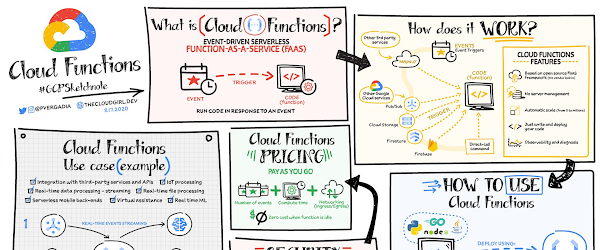
Learn Cloud Functions in a snap!
June 18, 2021
Microsoft Azure Virtual Training Day: Data Fundamentals
June 21, 2021 RALEIGH, N.C.
—
June 21, 2021
—
Red Hat, Inc., the world’s leading provider of open source solutions, today announced new end-to-end Kubernetes-native decision management capabilities as part of the latest release of Red Hat Process Automation. Based on the open source Kogito project, the new capabilities enable individual business decisions to be created and deployed as containerized microservices that are managed by Kubernetes alongside other containers in the application environment, reducing redundancy and the footprint of traditional decision management systems when deploying in cloud-native environments like Red Hat OpenShift.
The use of Kogito in Red Hat’s new version of Process Automation Manager represents a first step in the much-needed fundamental architectural change in process automation software.
/>
According to industry analyst firm IDC, “By 2024, 75% of enterprises will prioritize infrastructure agility and operational efficiency, leading to a 5x increase in the adoption of cloud-native architectures for business applications.”1 As the industry accelerates toward cloud-centric infrastructure and applications, automation technologies like decision management play an important role in enabling businesses to quickly adapt to changing market conditions.
Decision management runtimes
The new decision management runtimes build on existing capabilities that incorporate decision modeling tools into development environments like Visual Studio Code (VSCode), allowing developers to use business rules and modeling languages like decision model and notation (DMN) as part of a development project.
Decision microservices on Quarkus
Developers also have access to additional features that enable them to set business rules and more effectively create decision microservices on Quarkus, including:
-
Access to low-level Drools Rule Language (DRL) to write rules and associated rule units
-
Generators, to provide automated REST and OpenAPI endpoints from the DMN models and DRL rules, as understanding inputs and outputs are needed in order to make requested decisions
-
Add-ons, to allow developers to add operational and domain-specific monitoring metrics (DRL decisions provide only operational metrics) and assets for decision streaming of CloudEvents using Apache Kafka
Apache Kafka integration
Red Hat Process Automation is now integrated with Red Hat AMQ and Apache Kafka, a distributed data streaming platform that can publish, subscribe to, store, and process streams of records in real time. It is designed to handle data streams from multiple sources and deliver them to multiple consumers. Developers can connect to Apache Kafka events in multiple ways, including:
-
Starting or resuming reactive business process by acting on events received by the ecosystem
-
Emitting events from processes based on the key business behaviors and notifying the ecosystem about certain changes
-
Tracking the ongoing activity for processes, cases and tasks through native Kafka event emitters when transactions are committed
Red Hat build of OptaPlanner 8
Red Hat Process Automation now includes OptaPlanner 8, a lightweight, embeddable planning engine that enables Java programmers to solve optimization problems efficiently. OptaPlanner 8 fully supports Quarkus, and includes new Quarkus-based quickstarts, such as vehicle route planning, employee rostering and vaccination scheduling.
Capabilities introduced via the latest release of Red Hat Process Automation are in addition to features included in previous releases. Red Hat continues to support customers using previous releases of the technology.
Red Hat Process Automation is a curated collection of software products from the Red Hat Application Services Portfolio that provide a comprehensive platform for developing cloud-native applications that automate business processes and decisions, including Red Hat Process Automation Manager, Red Hat Decision Manager, and Red Hat Runtimes.
Red Hat Process Automation gives users the ability to capture business policies and procedures, create applications that automate business operations and measure the results of business activities. It includes graphical tools that foster collaboration between IT and business users and provides better visibility into the rules and procedures that govern business applications.
Availability
The latest release of Red Hat Process Automation is available now. Customers can get the latest updates from the Red Hat Customer Portal.
Supporting Quotes
Rich Sharples, Senior Director, Product Management, Red Hat
“Enterprise business and IT leaders are continuing to employ process automation to automate operations, effectively utilize time and resources and make way for new digital innovation. The release of Red Hat Process Automation Manager 7.11 provides users with advanced tools that help them automate complex business decisions and procedures in order to digitally transform their organizations.”
Eduardo Hormazabal Gomez, Subgerente de Continuidad Tecnologica, Banco de Credito e Inversiones
“With Red Hat Process Automation, Banco de Credito e Inversiones was able to develop an easy-to-use solution to business operation challenges. The financial industry is an ever-changing environment and we need a process automation tool that allows us to quickly and flexibly respond to new conditions and circumstances. Red Hat Process Automation’s business process management and business rule management capabilities are smooth to maintain and adapt when needed.”
Kent Eudy, Executive Director, Vizuri
“The newest release of Red Hat Process Automation with new Kogito-based capabilities combines the high-performance decision making power of Drools with BPMN and DMN, enabling developers to leverage OpenShift and create cloud-native applications. This allows organizations looking to build more customer-centric and reactive architectures to support developers in implementing business-driven core processes and decisions. These Kogito-based capabilities are valuable tools needed to build intelligent “scale to zero” microservice applications.”
Maureen Fleming, Program VP of Intelligent Process Automation Research, IDC
“In addition to the increased adoption of cloud-native architectures, automated business operations are expected to continue to grow, behave more dynamically and become increasingly event driven over the next few years. This growth is the result of organizations integrating automation technologies like decision management into their business strategies in order to scale their operations in a cloud-centric world. The use of Kogito in Red Hat’s new version of Process Automation Manager represents a first step in the much-needed fundamental architectural change in process automation software.”
Additional Resources
Connect with Red Hat
-
Learn more about Red Hat
-
Get more news in the Red Hat newsroom
-
Read the Red Hat blog
-
Follow Red Hat on Twitter
-
Join Red Hat on Facebook
-
Watch Red Hat videos on YouTube
-
Follow Red Hat on LinkedIn




